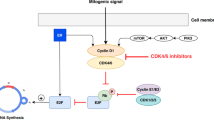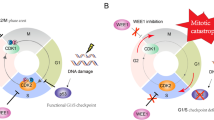Abstract
Our previous study established the human multi-drug-resistant cholangiocarcinoma cell line QBC939/ADM. In this study, we investigate further the ability of tamoxifen (TAM) to reverse drug-resistance to chemotherapeutics using QBC939/ADM cells. Cell growth inhibition was determined by the MTT assay, while cell cycle progression, apoptosis and the intra-cellular concentration of adriamycin (ADM) were all determined by flow cytometry. P-glycoprotein (P-gp) protein and mRNA expression was determined by Western blotting and real-time PCR. Growth inhibition and apoptosis induced by ADM, mitomycin (MMC), or vindesine (VDS) were enhanced after pre-treatment with 5 or 10 μM TAM, while only VDS increased cell numbers in the G2/M phase. The intra-cellular concentration of ADM rose after pre-treatment with 10 μM TAM, but not 5 μM TAM. Furthermore, real-time PCR and western blot analysis revealed down-regulation of P-gp expression in QBC939/ADM cells after TAM pre-treatment. The enhanced effects of TAM on growth inhibition, apoptosis, and intra-cellular concentration and the down-regulation of P-gp expression were blocked by an anti-P-gp antibody. TAM (10 μM) may reverse the multi-drug-resistance (MDR) of QBC939/ADM and enhance the chemotherapeutic effects on cholangiocarcinoma, by competitively inhibiting over-expressed P-gp.






Similar content being viewed by others
References
de Groen PC, Gores GJ, LaRusso NF, Gunderson LL, Nagorney DM (1999) Biliary tract cancers. N Engl J Med 341:1368–1378
Lazaridis KN, Gores GJ (2005) Cholangiocarcinoma. Gastroenterology 128:1655–1667
Jarnagin WR, Fong Y, DeMatteo RP, Gonen M, Burke EC, Bodniewicz BJ, Youssef BM, Klimstra D, Blumgart LH (2001) Staging, resectability, and outcome in 225 patients with hilar cholangiocarcinoma. Ann Surg 234:507–517 discussion 517–509
Weber SM, DeMatteo RP, Fong Y, Blumgart LH, Jarnagin WR (2002) Staging laparoscopy in patients with extrahepatic biliary carcinoma. Analysis of 100 patients. Ann Surg 235:392–399
Mosconi S, Beretta GD, Labianca R, Zampino MG, Gatta G, Heinemann V (2009) Cholangiocarcinoma. Crit Rev Oncol Hematol 69:259–270
Todoroki T, Kawamoto T, Koike N, Fukao K, Shoda J, Takahashi H (2001) Treatment strategy for patients with middle and lower third bile duct cancer. Br J Surg 88:364–370
Sirica AE (2005) Cholangiocarcinoma: molecular targeting strategies for chemoprevention and therapy. Hepatology 41:5–15
Incles CM, Schultes CM, Kelland LR, Neidle S (2003) Acquired cellular resistance to flavopiridol in a human colon carcinoma cell line involves up-regulation of the telomerase catalytic subunit and telomere elongation. Sensitivity of resistant cells to combination treatment with a telomerase inhibitor. Mol Pharmacol 64:1101–1108
Liu ZH, He YP, Qin HL (2010) The growth-inhibition effect of tamoxifen in the combination chemotherapeutics on the human cholangiocarcinoma cell line QBC939. Mol Biol Rep 37:2693–2701
Takada T, Amano H, Yasuda H, Nimura Y, Matsushiro T, Kato H, Nagakawa T, Nakayama T (2002) Is postoperative adjuvant chemotherapy useful for gallbladder carcinoma? A phase III multicenter prospective randomized controlled trial in patients with resected pancreaticobiliary carcinoma. Cancer 95:1685–1695
Rao S, Cunningham D, Hawkins RE, Hill ME, Smith D, Daniel F, Ross PJ, Oates J, Norman AR (2005) Phase III study of 5FU, etoposide and leucovorin (FELV) compared to epirubicin, cisplatin and 5FU (ECF) in previously untreated patients with advanced biliary cancer. Br J Cancer 92:1650–1654
Shaib Y, El-Serag HB (2004) The epidemiology of cholangiocarcinoma. Semin Liver Dis 24:115–125
Han P, Kang JH, Li HL, Hu SX, Lian HH, Qiu PP, Zhang J, Li WG, Chen QX (2009) Antiproliferation and apoptosis induced by tamoxifen in human bile duct carcinoma QBC939 cells via upregulated p53 expression. Biochem Biophys Res Commun 385:251–256
Derome A, Hoischen C, Bussiek M, Grady R, Adamczyk M, Kedzierska B, Diekmann S, Barilla D, Hayes F (2008) Centromere anatomy in the multidrug-resistant pathogen Enterococcus faecium. Proc Natl Acad Sci USA 105:2151–2156
Fricke WF, Welch TJ, McDermott PF, Mammel MK, LeClerc JE, White DG, Cebula TA, Ravel J (2009) Comparative genomics of the IncA/C multidrug resistance plasmid family. J Bacteriol 191:4750–4757
Kerb R, Hoffmeyer S, Brinkmann U (2001) ABC drug transporters: hereditary polymorphisms and pharmacological impact in MDR1, MRP1 and MRP2. Pharmacogenomics 2:51–64
Seo S, Hatano E, Higashi T, Nakajima A, Nakamoto Y, Tada M, Tamaki N, Iwaisako K, Kitamura K, Ikai I, Uemoto S (2009) P-glycoprotein expression affects 18F-fluorodeoxyglucose accumulation in hepatocellular carcinoma in vivo and in vitro. Int J Oncol 34:1303–1312
Liu ZH, He YP, Zhou Y, Zhang P, Qin HL (2010) Establishment and identification of the human multi-drug-resistant cholangiocarcinoma cell line QBC939/ADM. Mol Biol Rep. doi:10.1007/s11033-010-9975-7
Ferguson PJ, Brisson AR, Koropatnick J, Vincent MD (2009) Enhancement of cytotoxicity of natural product drugs against multidrug resistant variant cell lines of human head and neck squamous cell carcinoma and breast carcinoma by tesmilifene. Cancer Lett 274:279–289
Zhang M, Wang XQ, Zhou YK, Ma YL, Shen TY, Chen HQ, Chu ZX, Qin HL (2009) Effects of oral Lactobacillus plantarum on hepatocyte tight junction structure and function in rats with obstructive jaundice. Mol Biol Rep 37:2989–2999
Andersen J, Kamby C, Ejlertsen B, Cold S, Ewertz M, Jacobsen EH, Philip P, Moller KA, Jensen D, Moller S (2008) Tamoxifen for one year versus two years versus 6 months of Tamoxifen and 6 months of megestrol acetate: a randomized comparison in postmenopausal patients with high-risk breast cancer (DBCG 89C). Acta Oncol 47:718–724
Shervington A, Pawar V, Menon S, Thakkar D, Patel R (2009) The sensitization of glioma cells to cisplatin and tamoxifen by the use of catechin. Mol Biol Rep 36:1181–1186
Lipov EG, Joshi JR, Sanders S (2009) A new mechanism of action for tamoxifen. Lancet Oncol 10:542
Yoshino T, Hirabe H, Takahashi M, Kuhara M, Takeyama H, Matsunaga T (2008) Magnetic cell separation using nano-sized bacterial magnetic particles with reconstructed magnetosome membrane. Biotechnol Bioeng 101:470–477
Tolcher AW, Sarantopoulos J, Patnaik A, Papadopoulos K, Lin CC, Rodon J, Murphy B, Roth B, McCaffery I, Gorski KS, Kaiser B, Zhu M, Deng H, Friberg G, Puzanov I (2009) Phase I, pharmacokinetic, and pharmacodynamic study of AMG 479, a fully human monoclonal antibody to insulin-like growth factor receptor 1. J Clin Oncol 27:5800–5807
Jarnagin WR, Schwartz LH, Gultekin DH, Gonen M, Haviland D, Shia J, D’Angelica M, Fong Y, Dematteo R, Tse A, Blumgart LH, Kemeny N (2009) Regional chemotherapy for unresectable primary liver cancer: results of a phase II clinical trial and assessment of DCE-MRI as a biomarker of survival. Ann Oncol 20:1589–1595
Sato KT, Lewandowski RJ, Mulcahy MF, Atassi B, Ryu RK, Gates VL, Nemcek A A Jr, Barakat O, Benson A 3rd, Mandal R, Talamonti M, Wong CY, Miller FH, Newman SB, Shaw JM, Thurston KG, Omary RA, Salem R (2008) Unresectable chemorefractory liver metastases: radioembolization with 90Y microspheres—safety, efficacy, and survival. Radiology 247:507–515
Melum E, Karlsen TH, Schrumpf E, Bergquist A, Thorsby E, Boberg KM, Lie BA (2008) Cholangiocarcinoma in primary sclerosing cholangitis is associated with NKG2D polymorphisms. Hepatology 47:90–96
Onori P, DeMorrow S, Gaudio E, Franchitto A, Mancinelli R, Venter J, Kopriva S, Ueno Y, Alvaro D, Savage J, Alpini G, Francis H (2009) Caffeic acid phenethyl ester decreases cholangiocarcinoma growth by inhibition of NF-kappaB and induction of apoptosis. Int J Cancer 125:565–576
Liu B, Herve J, Bioulac-Sage P, Valogne Y, Roux J, Yilmaz F, Boisgard R, Guettier C, Cales P, Tavitian B, Samuel D, Clerc J, Brechot C, Faivre J (2007) Sodium iodide symporter is expressed at the preneoplastic stages of liver carcinogenesis and in human cholangiocarcinoma. Gastroenterology 132:1495–1503
Acknowledgments
All authors have no conflict of interests. The authors thank Shanghai Jiao Tong University Affiliated Sixth People’s Hospital for technical assistance during this study. This work was financially supported by National Natural Science Foundation of China (No. 30672044), the National Basic Research Program of China (No. 2008CB517403), and the Specialized Research Fund for the Doctoral Program of Higher Education of China (Grant No. BXJ0929).
Author information
Authors and Affiliations
Corresponding author
Electronic supplementary material
Below is the link to the electronic supplementary material.
Rights and permissions
About this article
Cite this article
Liu, ZH., Ma, YL., He, YP. et al. Tamoxifen reverses the multi-drug-resistance of an established human cholangiocarcinoma cell line in combined chemotherapeutics. Mol Biol Rep 38, 1769–1775 (2011). https://doi.org/10.1007/s11033-010-0291-z
Received:
Accepted:
Published:
Issue Date:
DOI: https://doi.org/10.1007/s11033-010-0291-z




